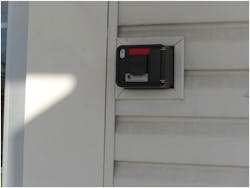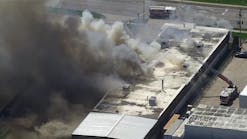There are several significant tasks that must be done within the first few minutes after the fire department arrives on the scene of a working structure fire. One of these tasks includes forcible entry; gaining access for crews to perform rescue and suppression is a high priority on the fireground. Truck companies are usually assigned this task, but the first-due engine company may find themselves making access for their initial push into the structure. There are a few considerations to make before the attack commences, to ensure the operation is rapid and efficient.
Pre-plan For Entry
Knowing the best way into the structure begins with the department pre-plan. Gathering as much information about the structure, prior to the fire, arms the incident commander with plenty of ammunition to formulate an attack. Getting into the building starts the attack.The easiest way into the building is to be invited, so to speak.
Many departments participate in the entry lock key program, commonly referred to by the trade name “Knox Box” system (see Photo 1). Having access into the building utilizing this system gets personnel and resources into the building quicker, reduces damage to the structure, and provides for a rapid suppression operation. It also adds an additional level of security, as some types allow the box to be wired into the master alarm system and notifies the police department when the box is unlocked.
If forcing entry is still necessary, consider the easiest way into the building; the easiest way may not be the most obvious way. Be sure that 360-degree pre-plan includes the point of attack, which should be the fastest, most efficient way in.
Upon Arrival
At the incident, gathering information regarding forcible entry can be broken down into five parts:
What is the occupancy? – What is the main use for the building? Does the operation of the building require significant security systems in place? Post offices, banks and medical facilities may all have areas that are fortified, requiring a more aggressive approach to gain entry.
Even residential structures may pose significant entry issues. Take for example a multiple dwelling such as an apartment complex, a hotel or even a multiple-family residential structure. The forcible entry team will have to gain entry into each exposed area, and depending on the respective occupant’s position on personal security, the crew may come across many different styles of locks in an entry door (see Photo 2).
In the case of hotels, many chains are changing over to electro-magnetic locks that are activated with a card-swipe system. These doors require a considerable amount of force, usually at more than one location on the jamb. It is much simpler for the staff to program a master swipe card for the fire department and have it accessible in an area for the company to use during an alarm. Additionally, in some cases, many of these occupancies fail-safe to the unlocked position in the event of a fire; check with these occupancies in your area to see how they react during an alarm.
Door Construction – What is the door and the jamb area made of? It is important to recognize what part of the assembly will fail during entry. Residential doors are usually wooden core doors, mounted in wood frames. In this event, the door or the frame will compromise. When gaining entry into a commercial occupancy, crews may encounter metal doors assembled in masonry walls and metal jambs. These assemblies will require a more laborious effort to gain entry. This author has even faced wooden entry doors within metal buildings. It is critical to identify the weak point of the assembly to direct the force towards (see Photo 3).
Additionally, how many doors are located at the point of entry? The entry team may come across a second door (such as in a foyer in an occupancy) that will be as significantly fortified as the first door encountered. Will this additional door cause enough of a delay that the suppression operation suffers? If so, think about finding an alternate means of entry (see Photo 4).
Consider the door that is mostly glass. These ornate doors are found mostly on commercial occupancies, and can be constructed as tempered glass with locks directly installed in the door, or be surrounded with wooden or metal door frames that hold the lock assemblies.
Forcing these doors will require a bit more time and thought than others, for a few reasons. First, breaking the glass to gain access can add other issues to the equation: There are usually panic bars and associated hardware in these doors that have to be cleared for entry along with the glass. Secondly, broken glass remaining in the frames can cut the advancing hose into the structure, causing the line to fail. Also, controlling the door is a critical factor in controlling air flow into the structure, in the event there is a significant change in conditions (i.e., backdraft or flashover). Once the glass is gone, there is no control for the access point to limit ventilation. Studies have proven there is a direct correlation between the wide-open attack point to a reduction in time before flashover, and not being able to limit ventilation from this point can prove detrimental. Forcing these doors can cause the glass to shatter and fail; it may be beneficial to either cut the lock with a saw or find a different access point instead of taking the time to go through the lock in a glass pane door (see Photo 5).
How is the door hung? – Looking at the door upon arrival, critical points can be identified. Does the door open inward or outward? Most residential dwellings have front doors that will open inward, while commercial occupancies will have doors that swing outward, allowing for rapid egress of occupants in the event of an emergency. It might be easier to remove the hinge pins on the outward swinging door to gain access than to try to force the multitude of locks on the door.
What types of locks are in the door? – Being able to defeat the locking devices is the primary objective of gaining access into the structure. It is critical that the entry team “reads the door” to determine what type of locks are securing the door. Look for bolt heads, drop-bar brackets, slide-bar bolts or any other clue displayed on the outer side of the door; it may be necessary for the crew to break off the heads of the bolts that are holding these devices in place, and then let the locking assembly drop out of the way to allow access into the building (see Photo 6).
When it comes to going through the lock mechanism to gain entry, efficient companies that are well versed in “through-the-lock” skills understand the way the lock operates; this way the lock can be manipulated correctly once the tumbler is removed (see photo 7). In the case of a well-advanced fire, there may not be time to access through the lock; if the mechanism cannot be defeated quickly, then it will be necessary to find an alternative method to gain access through that door, or another point of entry may be necessary altogether.
What is needed to force the door? The crew should be coming to the entry point with the necessary tools and equipment to force entry. Knowing the door construction, type of lock involved and where the assembly will fail will determine what tools are needed to gain access. Be sure the crew comes to the door ready for anything; a good practice is to bring a strong set of irons (preferably a large Halligan and a 16-pound maul) and a hydraulic force tool (HFT). This way, the crew is better prepared for just about anything they may encounter (see Photos 8 and 9).
Along with the tools, the company needs to be well-versed in their use. Forcible entry is not solely based on strength or brute force; one must recognize that the most efficient way to use the entry tools is determined by a working knowledge of leverage and mechanical advantage, and their intended application in a given situation. Knowing how to apply the benefit that the tools incorporate is how the company successfully enters the structure.
Tactical Considerations
Once the company has gained entry, their job is not over; there is a level of control that has to be considered when utilizing the entry point. In case there is a significant event awaiting the suppression team on the other side of the door, how will the company control the point? Most firefighters carry rope in their turnout pockets; tie a quick clove hitch or any other type of non-slip knot around the knob or handle in the event the door needs to be closed quickly. Additionally, the use of the adz end of the Halligan bar underneath the door while forcing will help limit the travel on the inward-opening door, allowing better management of the entry point.
Consider the entry point in the event of a catastrophic failure of the structure in the area: how will the company make their way out? How does the rapid intervention crew enter to facilitate rescue of the company? Once access is made into the structure for the suppression teams, the entry team must find a secondary access point in the structure, and announce its location over the radio; not only will it allow for tactical use during suppression, it will also serve as that critical “two ways out” access point for the interior operations. Consider a front door attack on a two-story wood-frame residential dwelling with a wrap-around porch on the front of the dwelling; the cantilevered porch has minimal support on the rail end, and could collapse over the front door, trapping the interior companies within the structure (see Photo 10).
Conclusion
The society we live in affords building owners with a multitude of various security devices for multiple applications in their facilities, be it residential or commercial. We must be prepared to find the easiest, most efficient way into these buildings to lessen the damage that the fire is inflicting on the structure. Knowing the best way in before the incident will help in making shorter work of the incident as a whole, keeping the people we serve, and the firefighters we serve with, safer in the big picture.
Until next time, stay focused and stay safe.
- See Michael Daley Live! Michael P. Daley will be teaching "It's in the Attic" and "First Due? Then It's Up To YOU! The Role Of The Initial Incident Commander" at Firehouse Expo in Baltimore, July 17 - 21.
MICHAEL P. DALEY is a lieutenant and training officer with the Monroe Township, NJ, Fire District No. 3, and is an instructor with the Middlesex County Fire Academy, where he is responsible for rescue training curriculum development. Mike has an extensive background in fire service operations and holds degrees in business management and public safety administration. Mike serves as a rescue officer with the New Jersey Urban Search and Rescue Task Force 1 and is a managing member for Fire Service Performance Concepts, a consultant group that provides assistance and support to fire departments with their training programs and course development. Mike has been guest on several Firehouse.com Podcasts including: Successful Rescue Operations in Today's Fire Service, Preparing for Tomorrow's RIT Deployment Today and Basement Fire Tactics Roundtable podcasts. You can reach Michael by e-mail at: [email protected].







